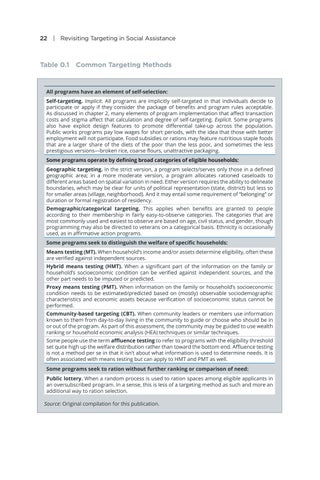22 | Revisiting Targeting in Social Assistance
Table 0.1 Common Targeting Methods
All programs have an element of self-selection: Self-targeting. Implicit. All programs are implicitly self-targeted in that individuals decide to participate or apply if they consider the package of benefits and program rules acceptable. As discussed in chapter 2, many elements of program implementation that affect transaction costs and stigma affect that calculation and degree of self-targeting. Explicit. Some programs also have explicit design features to promote differential take-up across the population. Public works programs pay low wages for short periods, with the idea that those with better employment will not participate. Food subsidies or rations may feature nutritious staple foods that are a larger share of the diets of the poor than the less poor, and sometimes the less prestigious versions—broken rice, coarse flours, unattractive packaging. Some programs operate by defining broad categories of eligible households: Geographic targeting. In the strict version, a program selects/serves only those in a defined geographic area; in a more moderate version, a program allocates rationed caseloads to different areas based on spatial variation in need. Either version requires the ability to delineate boundaries, which may be clear for units of political representation (state, district) but less so for smaller areas (village, neighborhood). And it may entail some requirement of “belonging” or duration or formal registration of residency. Demographic/categorical targeting. This applies when benefits are granted to people according to their membership in fairly easy-to-observe categories. The categories that are most commonly used and easiest to observe are based on age, civil status, and gender, though programming may also be directed to veterans on a categorical basis. Ethnicity is occasionally used, as in affirmative action programs. Some programs seek to distinguish the welfare of specific households: Means testing (MT). When household’s income and/or assets determine eligibility, often these are verified against independent sources. Hybrid means testing (HMT). When a significant part of the information on the family or household’s socioeconomic condition can be verified against independent sources, and the other part needs to be imputed or predicted. Proxy means testing (PMT). When information on the family or household’s socioeconomic condition needs to be estimated/predicted based on (mostly) observable sociodemographic characteristics and economic assets because verification of socioeconomic status cannot be performed. Community-based targeting (CBT). When community leaders or members use information known to them from day-to-day living in the community to guide or choose who should be in or out of the program. As part of this assessment, the community may be guided to use wealth ranking or household economic analysis (HEA) techniques or similar techniques. Some people use the term affluence testing to refer to programs with the eligibility threshold set quite high up the welfare distribution rather than toward the bottom end. Affluence testing is not a method per se in that it isn’t about what information is used to determine needs. It is often associated with means testing but can apply to HMT and PMT as well. Some programs seek to ration without further ranking or comparison of need: Public lottery. When a random process is used to ration spaces among eligible applicants in an oversubscribed program. In a sense, this is less of a targeting method as such and more an additional way to ration selection. Source: Original compilation for this publication.


